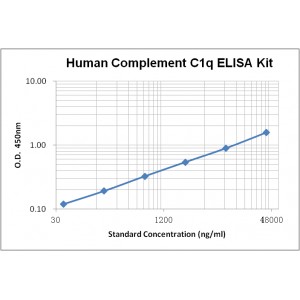More info
Assay Range | 39-40,000 pg/mL |
Sensitivity | 30 pg/mL |
Specificity | No cross-reaction with other related substances detected |
Size | 96T |
Storage | Store at 2 - 8ºC. Keep reconstituted standard and detection Ab at -20 ºC |
Assay Principle | Sandwich ELISA |
Sample Volume | 100 µL final volume, dilution factor varies on samples |
Detection Method | Chromogenic |
Kit Components
1. Recombinant Human C1q standard: 1 vial
2. One 96-well plate coated with Human C1q Ab
3. Diluent buffer (10x): 30 mL - 1
4. Biotinylated Human C1q Ab (50x): 140 µL
5. Streptavidin-HRP(100x): 80 µL
6. TMB developing agent: 8 mL x1
7. Stop solution: 12 mL x1
8. Washing solution (20x): 30 mL x2
Background
C1q is a part and the recognition subunit of the C1 complex composed of three different proteins (C1q, C1r, and C1s) bound together in a calcium-dependent complex. The C1 complex is the first complement component in the the classical pathway of complement. C1q is a 460-kDa protein comprising six heterotrimeric collagen-like triple helices. The globular heads of the C1q bind to the Fc-fragment of IgM or IgG on the surface of a pathogen, playing an important role in host defense and apoptotic cell clearance. It is a functional ligand for leukocyte-associated Ig-like receptor 1 restricting immune cell differentiation and activation. C1q prevents toxicity induced by oligomeric forms of amyloid-β. Failure to efficiently clear apoptotic cells in the absence of C1q is associated with lupus-like autoimmunity.


